HEA 563 Essay: Critical Analysis of CVC Infections
VerifiedAdded on 2023/01/07
|10
|3404
|89
Essay
AI Summary
This essay critically analyzes the high incidence of infections associated with central venous catheters (CVCs). It begins with an introduction to CVCs and their uses, followed by an examination of the statistics related to CVC infections, including incidence rates, mortality, and associated costs. The essay then delves into the factors contributing to biofilm development within CVCs, including the role of the immune and coagulation systems. Furthermore, it explores the pathophysiology of sepsis, leading to septic shock, and discusses the role of fluid therapy in managing septic shock. The essay provides a comprehensive overview of the topic, supported by relevant literature and research, and concludes with a summary of the key findings and implications for clinical practice.

Critical Thinking
Paraphrase This Document
Need a fresh take? Get an instant paraphrase of this document with our AI Paraphraser
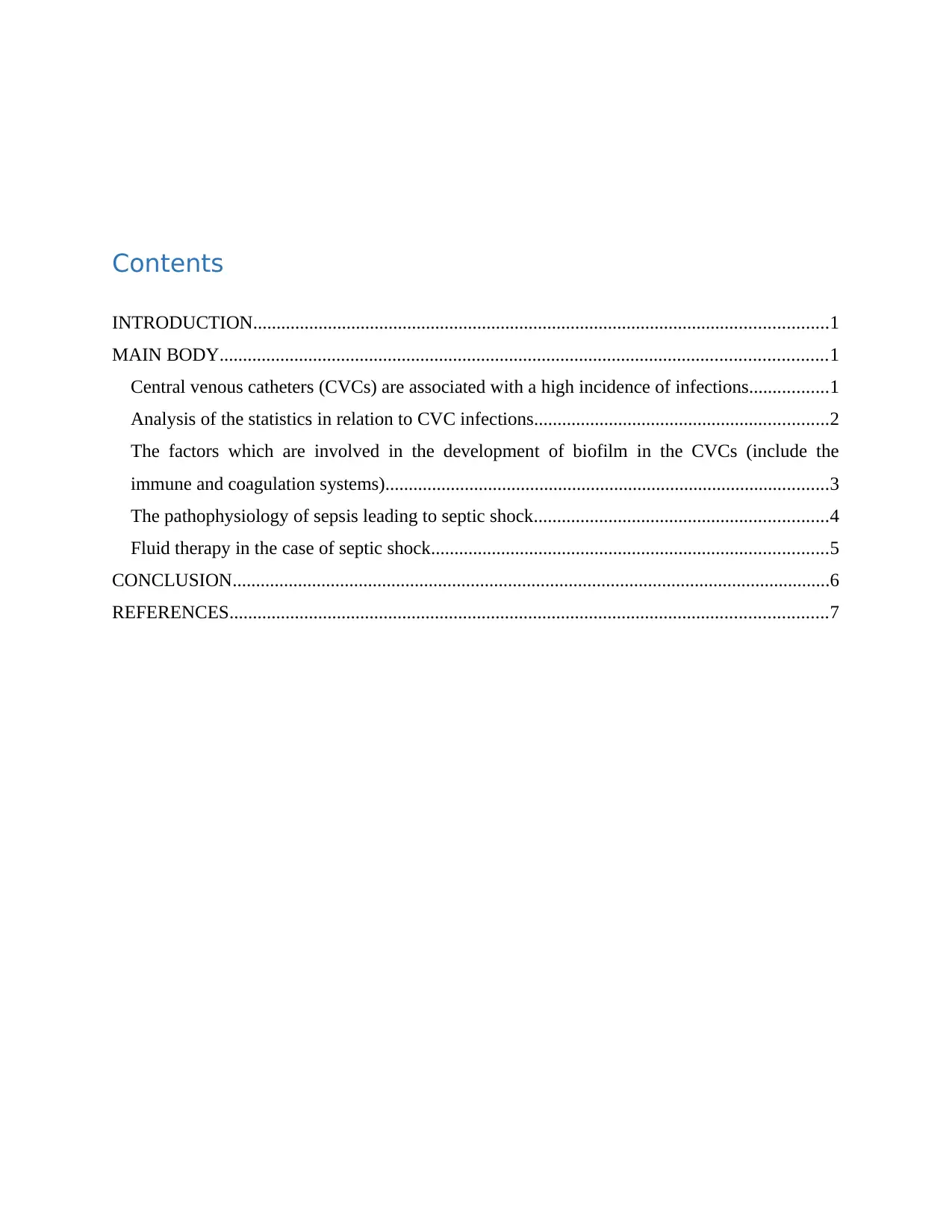
Contents
INTRODUCTION...........................................................................................................................1
MAIN BODY..................................................................................................................................1
Central venous catheters (CVCs) are associated with a high incidence of infections.................1
Analysis of the statistics in relation to CVC infections...............................................................2
The factors which are involved in the development of biofilm in the CVCs (include the
immune and coagulation systems)...............................................................................................3
The pathophysiology of sepsis leading to septic shock...............................................................4
Fluid therapy in the case of septic shock.....................................................................................5
CONCLUSION................................................................................................................................6
REFERENCES................................................................................................................................7
INTRODUCTION...........................................................................................................................1
MAIN BODY..................................................................................................................................1
Central venous catheters (CVCs) are associated with a high incidence of infections.................1
Analysis of the statistics in relation to CVC infections...............................................................2
The factors which are involved in the development of biofilm in the CVCs (include the
immune and coagulation systems)...............................................................................................3
The pathophysiology of sepsis leading to septic shock...............................................................4
Fluid therapy in the case of septic shock.....................................................................................5
CONCLUSION................................................................................................................................6
REFERENCES................................................................................................................................7
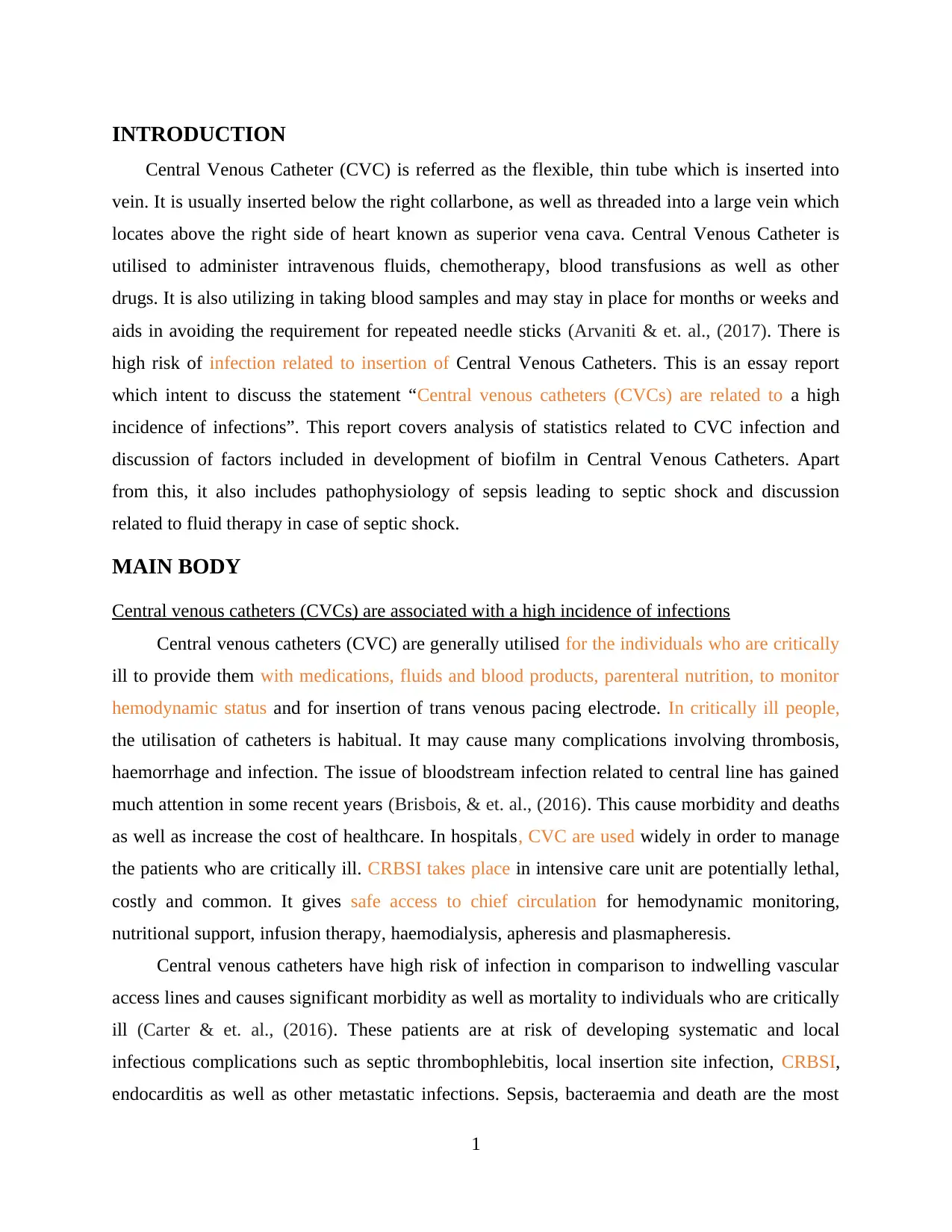
INTRODUCTION
Central Venous Catheter (CVC) is referred as the flexible, thin tube which is inserted into
vein. It is usually inserted below the right collarbone, as well as threaded into a large vein which
locates above the right side of heart known as superior vena cava. Central Venous Catheter is
utilised to administer intravenous fluids, chemotherapy, blood transfusions as well as other
drugs. It is also utilizing in taking blood samples and may stay in place for months or weeks and
aids in avoiding the requirement for repeated needle sticks (Arvaniti & et. al., (2017). There is
high risk of infection related to insertion of Central Venous Catheters. This is an essay report
which intent to discuss the statement “Central venous catheters (CVCs) are related to a high
incidence of infections”. This report covers analysis of statistics related to CVC infection and
discussion of factors included in development of biofilm in Central Venous Catheters. Apart
from this, it also includes pathophysiology of sepsis leading to septic shock and discussion
related to fluid therapy in case of septic shock.
MAIN BODY
Central venous catheters (CVCs) are associated with a high incidence of infections
Central venous catheters (CVC) are generally utilised for the individuals who are critically
ill to provide them with medications, fluids and blood products, parenteral nutrition, to monitor
hemodynamic status and for insertion of trans venous pacing electrode. In critically ill people,
the utilisation of catheters is habitual. It may cause many complications involving thrombosis,
haemorrhage and infection. The issue of bloodstream infection related to central line has gained
much attention in some recent years (Brisbois, & et. al., (2016). This cause morbidity and deaths
as well as increase the cost of healthcare. In hospitals, CVC are used widely in order to manage
the patients who are critically ill. CRBSI takes place in intensive care unit are potentially lethal,
costly and common. It gives safe access to chief circulation for hemodynamic monitoring,
nutritional support, infusion therapy, haemodialysis, apheresis and plasmapheresis.
Central venous catheters have high risk of infection in comparison to indwelling vascular
access lines and causes significant morbidity as well as mortality to individuals who are critically
ill (Carter & et. al., (2016). These patients are at risk of developing systematic and local
infectious complications such as septic thrombophlebitis, local insertion site infection, CRBSI,
endocarditis as well as other metastatic infections. Sepsis, bacteraemia and death are the most
1
Central Venous Catheter (CVC) is referred as the flexible, thin tube which is inserted into
vein. It is usually inserted below the right collarbone, as well as threaded into a large vein which
locates above the right side of heart known as superior vena cava. Central Venous Catheter is
utilised to administer intravenous fluids, chemotherapy, blood transfusions as well as other
drugs. It is also utilizing in taking blood samples and may stay in place for months or weeks and
aids in avoiding the requirement for repeated needle sticks (Arvaniti & et. al., (2017). There is
high risk of infection related to insertion of Central Venous Catheters. This is an essay report
which intent to discuss the statement “Central venous catheters (CVCs) are related to a high
incidence of infections”. This report covers analysis of statistics related to CVC infection and
discussion of factors included in development of biofilm in Central Venous Catheters. Apart
from this, it also includes pathophysiology of sepsis leading to septic shock and discussion
related to fluid therapy in case of septic shock.
MAIN BODY
Central venous catheters (CVCs) are associated with a high incidence of infections
Central venous catheters (CVC) are generally utilised for the individuals who are critically
ill to provide them with medications, fluids and blood products, parenteral nutrition, to monitor
hemodynamic status and for insertion of trans venous pacing electrode. In critically ill people,
the utilisation of catheters is habitual. It may cause many complications involving thrombosis,
haemorrhage and infection. The issue of bloodstream infection related to central line has gained
much attention in some recent years (Brisbois, & et. al., (2016). This cause morbidity and deaths
as well as increase the cost of healthcare. In hospitals, CVC are used widely in order to manage
the patients who are critically ill. CRBSI takes place in intensive care unit are potentially lethal,
costly and common. It gives safe access to chief circulation for hemodynamic monitoring,
nutritional support, infusion therapy, haemodialysis, apheresis and plasmapheresis.
Central venous catheters have high risk of infection in comparison to indwelling vascular
access lines and causes significant morbidity as well as mortality to individuals who are critically
ill (Carter & et. al., (2016). These patients are at risk of developing systematic and local
infectious complications such as septic thrombophlebitis, local insertion site infection, CRBSI,
endocarditis as well as other metastatic infections. Sepsis, bacteraemia and death are the most
1
⊘ This is a preview!⊘
Do you want full access?
Subscribe today to unlock all pages.

Trusted by 1+ million students worldwide
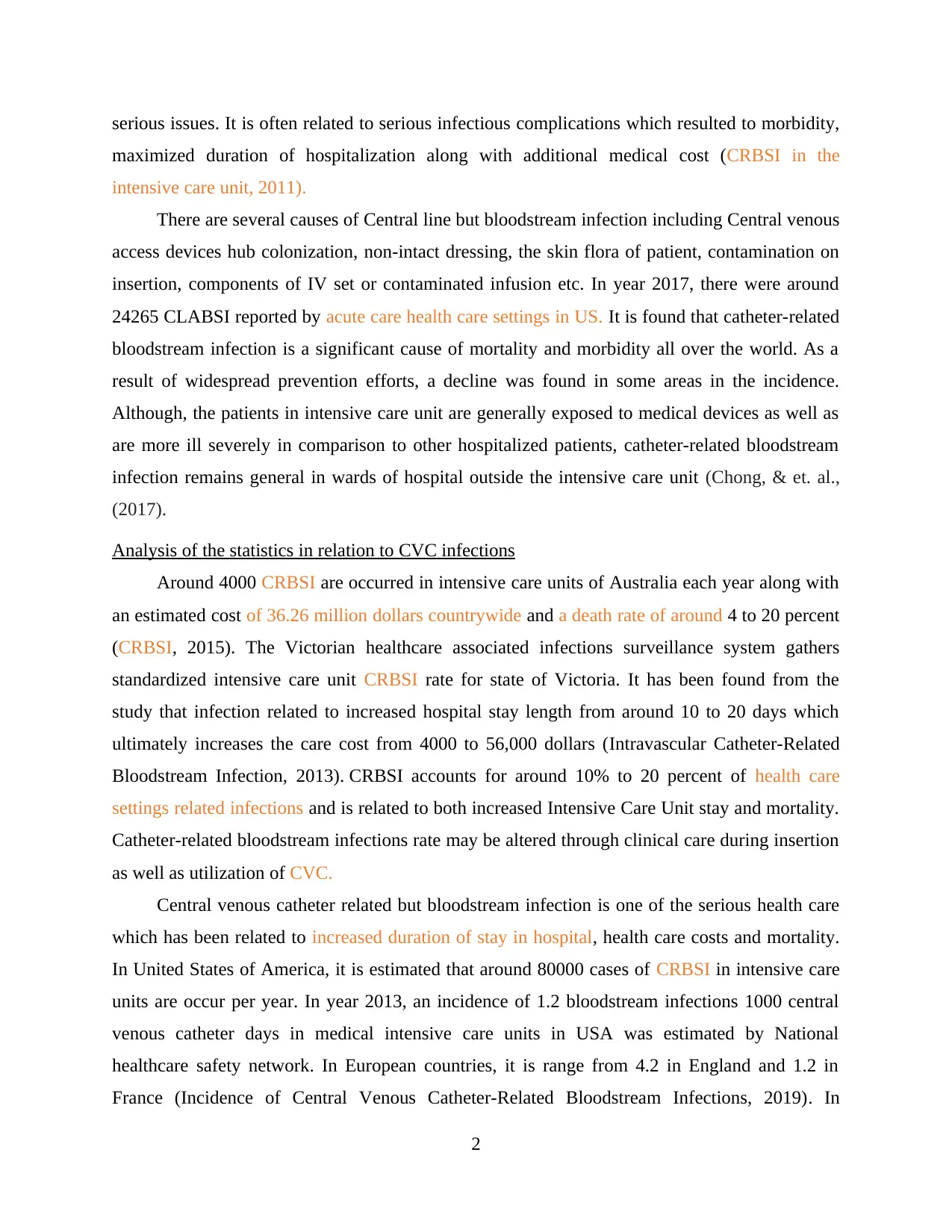
serious issues. It is often related to serious infectious complications which resulted to morbidity,
maximized duration of hospitalization along with additional medical cost (CRBSI in the
intensive care unit, 2011).
There are several causes of Central line but bloodstream infection including Central venous
access devices hub colonization, non-intact dressing, the skin flora of patient, contamination on
insertion, components of IV set or contaminated infusion etc. In year 2017, there were around
24265 CLABSI reported by acute care health care settings in US. It is found that catheter-related
bloodstream infection is a significant cause of mortality and morbidity all over the world. As a
result of widespread prevention efforts, a decline was found in some areas in the incidence.
Although, the patients in intensive care unit are generally exposed to medical devices as well as
are more ill severely in comparison to other hospitalized patients, catheter-related bloodstream
infection remains general in wards of hospital outside the intensive care unit (Chong, & et. al.,
(2017).
Analysis of the statistics in relation to CVC infections
Around 4000 CRBSI are occurred in intensive care units of Australia each year along with
an estimated cost of 36.26 million dollars countrywide and a death rate of around 4 to 20 percent
(CRBSI, 2015). The Victorian healthcare associated infections surveillance system gathers
standardized intensive care unit CRBSI rate for state of Victoria. It has been found from the
study that infection related to increased hospital stay length from around 10 to 20 days which
ultimately increases the care cost from 4000 to 56,000 dollars (Intravascular Catheter-Related
Bloodstream Infection, 2013). CRBSI accounts for around 10% to 20 percent of health care
settings related infections and is related to both increased Intensive Care Unit stay and mortality.
Catheter-related bloodstream infections rate may be altered through clinical care during insertion
as well as utilization of CVC.
Central venous catheter related but bloodstream infection is one of the serious health care
which has been related to increased duration of stay in hospital, health care costs and mortality.
In United States of America, it is estimated that around 80000 cases of CRBSI in intensive care
units are occur per year. In year 2013, an incidence of 1.2 bloodstream infections 1000 central
venous catheter days in medical intensive care units in USA was estimated by National
healthcare safety network. In European countries, it is range from 4.2 in England and 1.2 in
France (Incidence of Central Venous Catheter-Related Bloodstream Infections, 2019). In
2
maximized duration of hospitalization along with additional medical cost (CRBSI in the
intensive care unit, 2011).
There are several causes of Central line but bloodstream infection including Central venous
access devices hub colonization, non-intact dressing, the skin flora of patient, contamination on
insertion, components of IV set or contaminated infusion etc. In year 2017, there were around
24265 CLABSI reported by acute care health care settings in US. It is found that catheter-related
bloodstream infection is a significant cause of mortality and morbidity all over the world. As a
result of widespread prevention efforts, a decline was found in some areas in the incidence.
Although, the patients in intensive care unit are generally exposed to medical devices as well as
are more ill severely in comparison to other hospitalized patients, catheter-related bloodstream
infection remains general in wards of hospital outside the intensive care unit (Chong, & et. al.,
(2017).
Analysis of the statistics in relation to CVC infections
Around 4000 CRBSI are occurred in intensive care units of Australia each year along with
an estimated cost of 36.26 million dollars countrywide and a death rate of around 4 to 20 percent
(CRBSI, 2015). The Victorian healthcare associated infections surveillance system gathers
standardized intensive care unit CRBSI rate for state of Victoria. It has been found from the
study that infection related to increased hospital stay length from around 10 to 20 days which
ultimately increases the care cost from 4000 to 56,000 dollars (Intravascular Catheter-Related
Bloodstream Infection, 2013). CRBSI accounts for around 10% to 20 percent of health care
settings related infections and is related to both increased Intensive Care Unit stay and mortality.
Catheter-related bloodstream infections rate may be altered through clinical care during insertion
as well as utilization of CVC.
Central venous catheter related but bloodstream infection is one of the serious health care
which has been related to increased duration of stay in hospital, health care costs and mortality.
In United States of America, it is estimated that around 80000 cases of CRBSI in intensive care
units are occur per year. In year 2013, an incidence of 1.2 bloodstream infections 1000 central
venous catheter days in medical intensive care units in USA was estimated by National
healthcare safety network. In European countries, it is range from 4.2 in England and 1.2 in
France (Incidence of Central Venous Catheter-Related Bloodstream Infections, 2019). In
2
Paraphrase This Document
Need a fresh take? Get an instant paraphrase of this document with our AI Paraphraser
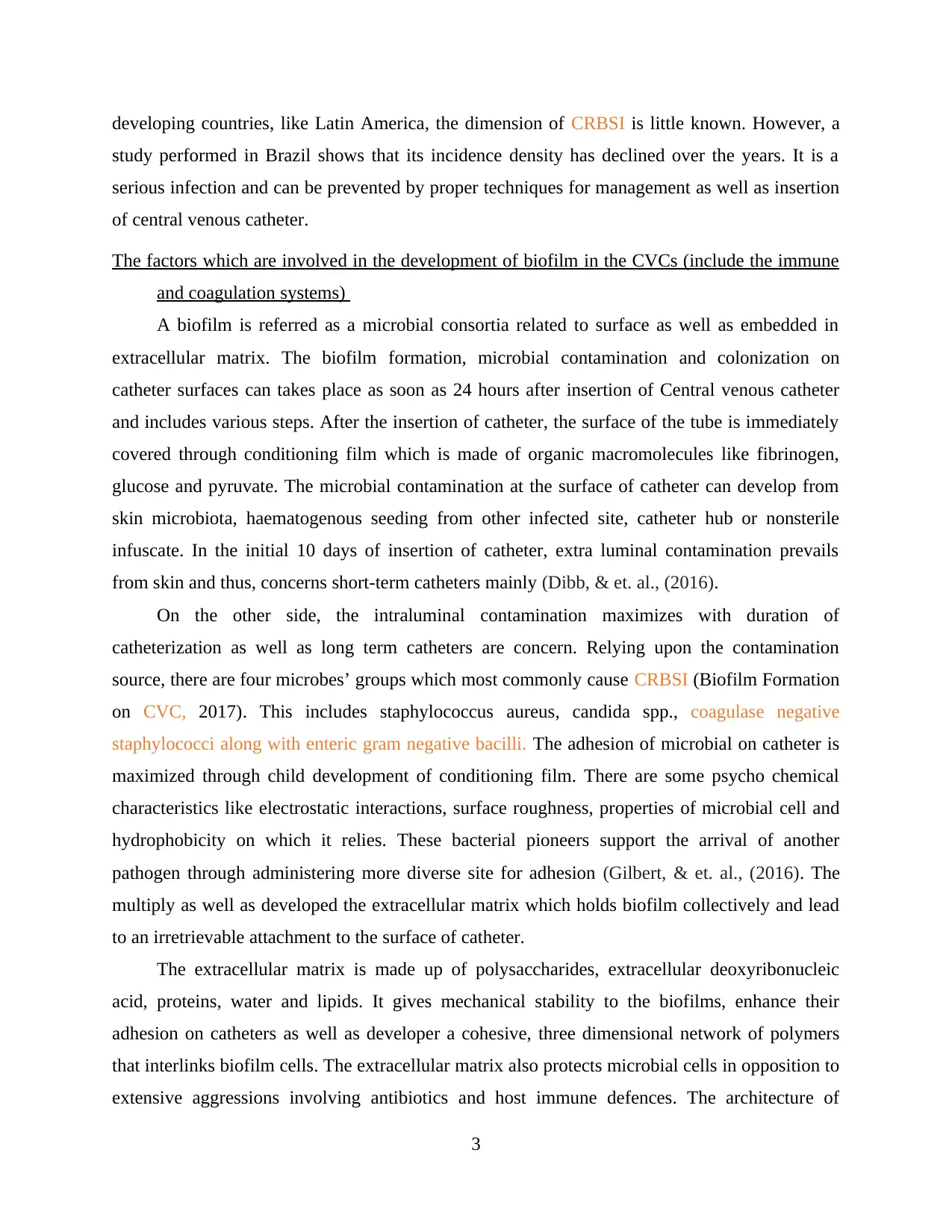
developing countries, like Latin America, the dimension of CRBSI is little known. However, a
study performed in Brazil shows that its incidence density has declined over the years. It is a
serious infection and can be prevented by proper techniques for management as well as insertion
of central venous catheter.
The factors which are involved in the development of biofilm in the CVCs (include the immune
and coagulation systems)
A biofilm is referred as a microbial consortia related to surface as well as embedded in
extracellular matrix. The biofilm formation, microbial contamination and colonization on
catheter surfaces can takes place as soon as 24 hours after insertion of Central venous catheter
and includes various steps. After the insertion of catheter, the surface of the tube is immediately
covered through conditioning film which is made of organic macromolecules like fibrinogen,
glucose and pyruvate. The microbial contamination at the surface of catheter can develop from
skin microbiota, haematogenous seeding from other infected site, catheter hub or nonsterile
infuscate. In the initial 10 days of insertion of catheter, extra luminal contamination prevails
from skin and thus, concerns short-term catheters mainly (Dibb, & et. al., (2016).
On the other side, the intraluminal contamination maximizes with duration of
catheterization as well as long term catheters are concern. Relying upon the contamination
source, there are four microbes’ groups which most commonly cause CRBSI (Biofilm Formation
on CVC, 2017). This includes staphylococcus aureus, candida spp., coagulase negative
staphylococci along with enteric gram negative bacilli. The adhesion of microbial on catheter is
maximized through child development of conditioning film. There are some psycho chemical
characteristics like electrostatic interactions, surface roughness, properties of microbial cell and
hydrophobicity on which it relies. These bacterial pioneers support the arrival of another
pathogen through administering more diverse site for adhesion (Gilbert, & et. al., (2016). The
multiply as well as developed the extracellular matrix which holds biofilm collectively and lead
to an irretrievable attachment to the surface of catheter.
The extracellular matrix is made up of polysaccharides, extracellular deoxyribonucleic
acid, proteins, water and lipids. It gives mechanical stability to the biofilms, enhance their
adhesion on catheters as well as developer a cohesive, three dimensional network of polymers
that interlinks biofilm cells. The extracellular matrix also protects microbial cells in opposition to
extensive aggressions involving antibiotics and host immune defences. The architecture of
3
study performed in Brazil shows that its incidence density has declined over the years. It is a
serious infection and can be prevented by proper techniques for management as well as insertion
of central venous catheter.
The factors which are involved in the development of biofilm in the CVCs (include the immune
and coagulation systems)
A biofilm is referred as a microbial consortia related to surface as well as embedded in
extracellular matrix. The biofilm formation, microbial contamination and colonization on
catheter surfaces can takes place as soon as 24 hours after insertion of Central venous catheter
and includes various steps. After the insertion of catheter, the surface of the tube is immediately
covered through conditioning film which is made of organic macromolecules like fibrinogen,
glucose and pyruvate. The microbial contamination at the surface of catheter can develop from
skin microbiota, haematogenous seeding from other infected site, catheter hub or nonsterile
infuscate. In the initial 10 days of insertion of catheter, extra luminal contamination prevails
from skin and thus, concerns short-term catheters mainly (Dibb, & et. al., (2016).
On the other side, the intraluminal contamination maximizes with duration of
catheterization as well as long term catheters are concern. Relying upon the contamination
source, there are four microbes’ groups which most commonly cause CRBSI (Biofilm Formation
on CVC, 2017). This includes staphylococcus aureus, candida spp., coagulase negative
staphylococci along with enteric gram negative bacilli. The adhesion of microbial on catheter is
maximized through child development of conditioning film. There are some psycho chemical
characteristics like electrostatic interactions, surface roughness, properties of microbial cell and
hydrophobicity on which it relies. These bacterial pioneers support the arrival of another
pathogen through administering more diverse site for adhesion (Gilbert, & et. al., (2016). The
multiply as well as developed the extracellular matrix which holds biofilm collectively and lead
to an irretrievable attachment to the surface of catheter.
The extracellular matrix is made up of polysaccharides, extracellular deoxyribonucleic
acid, proteins, water and lipids. It gives mechanical stability to the biofilms, enhance their
adhesion on catheters as well as developer a cohesive, three dimensional network of polymers
that interlinks biofilm cells. The extracellular matrix also protects microbial cells in opposition to
extensive aggressions involving antibiotics and host immune defences. The architecture of
3
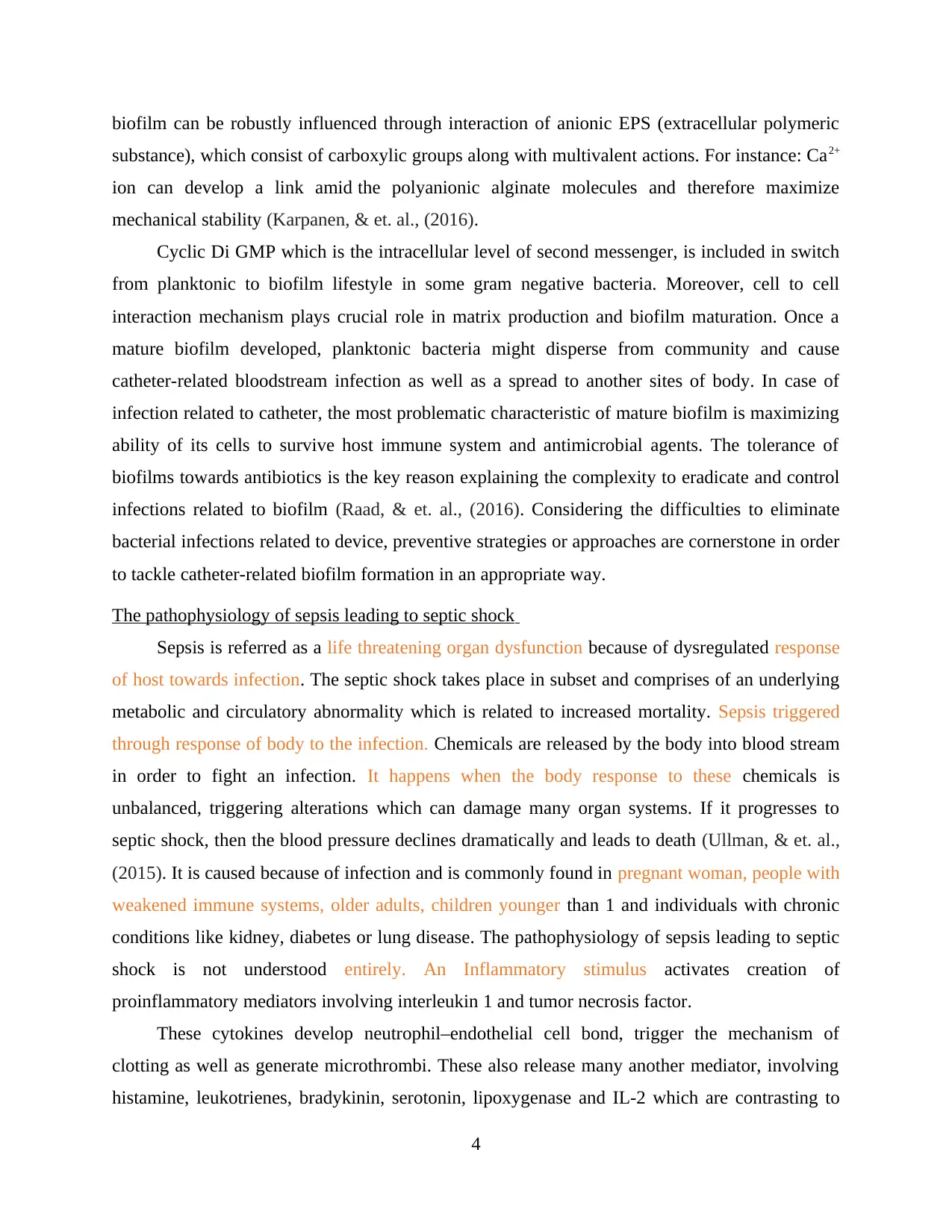
biofilm can be robustly influenced through interaction of anionic EPS (extracellular polymeric
substance), which consist of carboxylic groups along with multivalent actions. For instance: Ca2+
ion can develop a link amid the polyanionic alginate molecules and therefore maximize
mechanical stability (Karpanen, & et. al., (2016).
Cyclic Di GMP which is the intracellular level of second messenger, is included in switch
from planktonic to biofilm lifestyle in some gram negative bacteria. Moreover, cell to cell
interaction mechanism plays crucial role in matrix production and biofilm maturation. Once a
mature biofilm developed, planktonic bacteria might disperse from community and cause
catheter-related bloodstream infection as well as a spread to another sites of body. In case of
infection related to catheter, the most problematic characteristic of mature biofilm is maximizing
ability of its cells to survive host immune system and antimicrobial agents. The tolerance of
biofilms towards antibiotics is the key reason explaining the complexity to eradicate and control
infections related to biofilm (Raad, & et. al., (2016). Considering the difficulties to eliminate
bacterial infections related to device, preventive strategies or approaches are cornerstone in order
to tackle catheter-related biofilm formation in an appropriate way.
The pathophysiology of sepsis leading to septic shock
Sepsis is referred as a life threatening organ dysfunction because of dysregulated response
of host towards infection. The septic shock takes place in subset and comprises of an underlying
metabolic and circulatory abnormality which is related to increased mortality. Sepsis triggered
through response of body to the infection. Chemicals are released by the body into blood stream
in order to fight an infection. It happens when the body response to these chemicals is
unbalanced, triggering alterations which can damage many organ systems. If it progresses to
septic shock, then the blood pressure declines dramatically and leads to death (Ullman, & et. al.,
(2015). It is caused because of infection and is commonly found in pregnant woman, people with
weakened immune systems, older adults, children younger than 1 and individuals with chronic
conditions like kidney, diabetes or lung disease. The pathophysiology of sepsis leading to septic
shock is not understood entirely. An Inflammatory stimulus activates creation of
proinflammatory mediators involving interleukin 1 and tumor necrosis factor.
These cytokines develop neutrophil–endothelial cell bond, trigger the mechanism of
clotting as well as generate microthrombi. These also release many another mediator, involving
histamine, leukotrienes, bradykinin, serotonin, lipoxygenase and IL-2 which are contrasting to
4
substance), which consist of carboxylic groups along with multivalent actions. For instance: Ca2+
ion can develop a link amid the polyanionic alginate molecules and therefore maximize
mechanical stability (Karpanen, & et. al., (2016).
Cyclic Di GMP which is the intracellular level of second messenger, is included in switch
from planktonic to biofilm lifestyle in some gram negative bacteria. Moreover, cell to cell
interaction mechanism plays crucial role in matrix production and biofilm maturation. Once a
mature biofilm developed, planktonic bacteria might disperse from community and cause
catheter-related bloodstream infection as well as a spread to another sites of body. In case of
infection related to catheter, the most problematic characteristic of mature biofilm is maximizing
ability of its cells to survive host immune system and antimicrobial agents. The tolerance of
biofilms towards antibiotics is the key reason explaining the complexity to eradicate and control
infections related to biofilm (Raad, & et. al., (2016). Considering the difficulties to eliminate
bacterial infections related to device, preventive strategies or approaches are cornerstone in order
to tackle catheter-related biofilm formation in an appropriate way.
The pathophysiology of sepsis leading to septic shock
Sepsis is referred as a life threatening organ dysfunction because of dysregulated response
of host towards infection. The septic shock takes place in subset and comprises of an underlying
metabolic and circulatory abnormality which is related to increased mortality. Sepsis triggered
through response of body to the infection. Chemicals are released by the body into blood stream
in order to fight an infection. It happens when the body response to these chemicals is
unbalanced, triggering alterations which can damage many organ systems. If it progresses to
septic shock, then the blood pressure declines dramatically and leads to death (Ullman, & et. al.,
(2015). It is caused because of infection and is commonly found in pregnant woman, people with
weakened immune systems, older adults, children younger than 1 and individuals with chronic
conditions like kidney, diabetes or lung disease. The pathophysiology of sepsis leading to septic
shock is not understood entirely. An Inflammatory stimulus activates creation of
proinflammatory mediators involving interleukin 1 and tumor necrosis factor.
These cytokines develop neutrophil–endothelial cell bond, trigger the mechanism of
clotting as well as generate microthrombi. These also release many another mediator, involving
histamine, leukotrienes, bradykinin, serotonin, lipoxygenase and IL-2 which are contrasting to
4
⊘ This is a preview!⊘
Do you want full access?
Subscribe today to unlock all pages.

Trusted by 1+ million students worldwide

anti-inflammatory mediators, like IL-4 and IL-10, which resulted in an adverse feedback
mechanism. In the starting, arteries dilate, arterioles and declining peripheral arterial resistance
as well as cardiac output increases typically (Vasudevan, Oddie, & McGuire, (2016). This phase
called as warm shock. Later, the cardiac output might decline, BP decline and features of shock
appear. At the stage of maximized cardiac output, the vasoactive mediators lead to cause flow of
blood to evade capillary exchange vessels. Deprived flow of capillary outcome from this
shunting with capillary obstacle through microthrombi, declines the oxygen delivery as well as
impairs elimination of carbon dioxide along with waste products. Reduced perfusion causes
dysfunction as well as sometimes resulted to failure of one or multiple organs, involving the
brain, kidneys, liver, lungs, and heart. Due to intravascular coagulation with ingestion of main
clotting aspects, coagulopathy may develop, excessive fibrinolysis in response thereto, and more
frequently a mixture of both.
Fluid therapy in the case of septic shock
Septic shock can be referred as a systematic inflammatory response syndrome (IRS),
activated through an infection related to refractory hypotension. The systematic inflammation,
mitochondrial dysfunction, tissue hypo perfusion, microvascular abnormalities and therapeutic
interventions develop on septic patients give rise to organ failure and death. Fluid therapy is the
first line intervention for treating sepsis. It restores the systematic hemodynamic and maximize
delivery of oxygen in order to match its demand in septic patient. As per the guidelines provided
by surviving sepsis movement, the septic patients presenting hypertension, tissue hypo perfusion,
and admitted to emergency division should get an initial fluid load along with 30mL per
kilogram of body weight of crystalloids (Yamaguchi, & et. al., (2017). The key reason to provide
fluid therapy to septic shock patients might be justified based on vascular bed alterations.
The inflammatory mediators which are act on endothelial cells encourage vasodilation that
outcomes in relative hypovolemia. Thus, an enough fluid replacement is necessary to maintain
the perfusion pressure as well as flow of blood to the tissues. By providing the fluids, the
systematic flow of blood, oxygenation and tissue perfusion can be accomplished through
restoring intravascular compartment. There are two assumptions on the basis of which fluids
must be provided in presence of fluid responsiveness which means when fluid provision will
increase cardiac output and in existence of impaired tissue perfusion needing blood flow
augmentation (Zanwar, & et. al., (2019).
5
mechanism. In the starting, arteries dilate, arterioles and declining peripheral arterial resistance
as well as cardiac output increases typically (Vasudevan, Oddie, & McGuire, (2016). This phase
called as warm shock. Later, the cardiac output might decline, BP decline and features of shock
appear. At the stage of maximized cardiac output, the vasoactive mediators lead to cause flow of
blood to evade capillary exchange vessels. Deprived flow of capillary outcome from this
shunting with capillary obstacle through microthrombi, declines the oxygen delivery as well as
impairs elimination of carbon dioxide along with waste products. Reduced perfusion causes
dysfunction as well as sometimes resulted to failure of one or multiple organs, involving the
brain, kidneys, liver, lungs, and heart. Due to intravascular coagulation with ingestion of main
clotting aspects, coagulopathy may develop, excessive fibrinolysis in response thereto, and more
frequently a mixture of both.
Fluid therapy in the case of septic shock
Septic shock can be referred as a systematic inflammatory response syndrome (IRS),
activated through an infection related to refractory hypotension. The systematic inflammation,
mitochondrial dysfunction, tissue hypo perfusion, microvascular abnormalities and therapeutic
interventions develop on septic patients give rise to organ failure and death. Fluid therapy is the
first line intervention for treating sepsis. It restores the systematic hemodynamic and maximize
delivery of oxygen in order to match its demand in septic patient. As per the guidelines provided
by surviving sepsis movement, the septic patients presenting hypertension, tissue hypo perfusion,
and admitted to emergency division should get an initial fluid load along with 30mL per
kilogram of body weight of crystalloids (Yamaguchi, & et. al., (2017). The key reason to provide
fluid therapy to septic shock patients might be justified based on vascular bed alterations.
The inflammatory mediators which are act on endothelial cells encourage vasodilation that
outcomes in relative hypovolemia. Thus, an enough fluid replacement is necessary to maintain
the perfusion pressure as well as flow of blood to the tissues. By providing the fluids, the
systematic flow of blood, oxygenation and tissue perfusion can be accomplished through
restoring intravascular compartment. There are two assumptions on the basis of which fluids
must be provided in presence of fluid responsiveness which means when fluid provision will
increase cardiac output and in existence of impaired tissue perfusion needing blood flow
augmentation (Zanwar, & et. al., (2019).
5
Paraphrase This Document
Need a fresh take? Get an instant paraphrase of this document with our AI Paraphraser
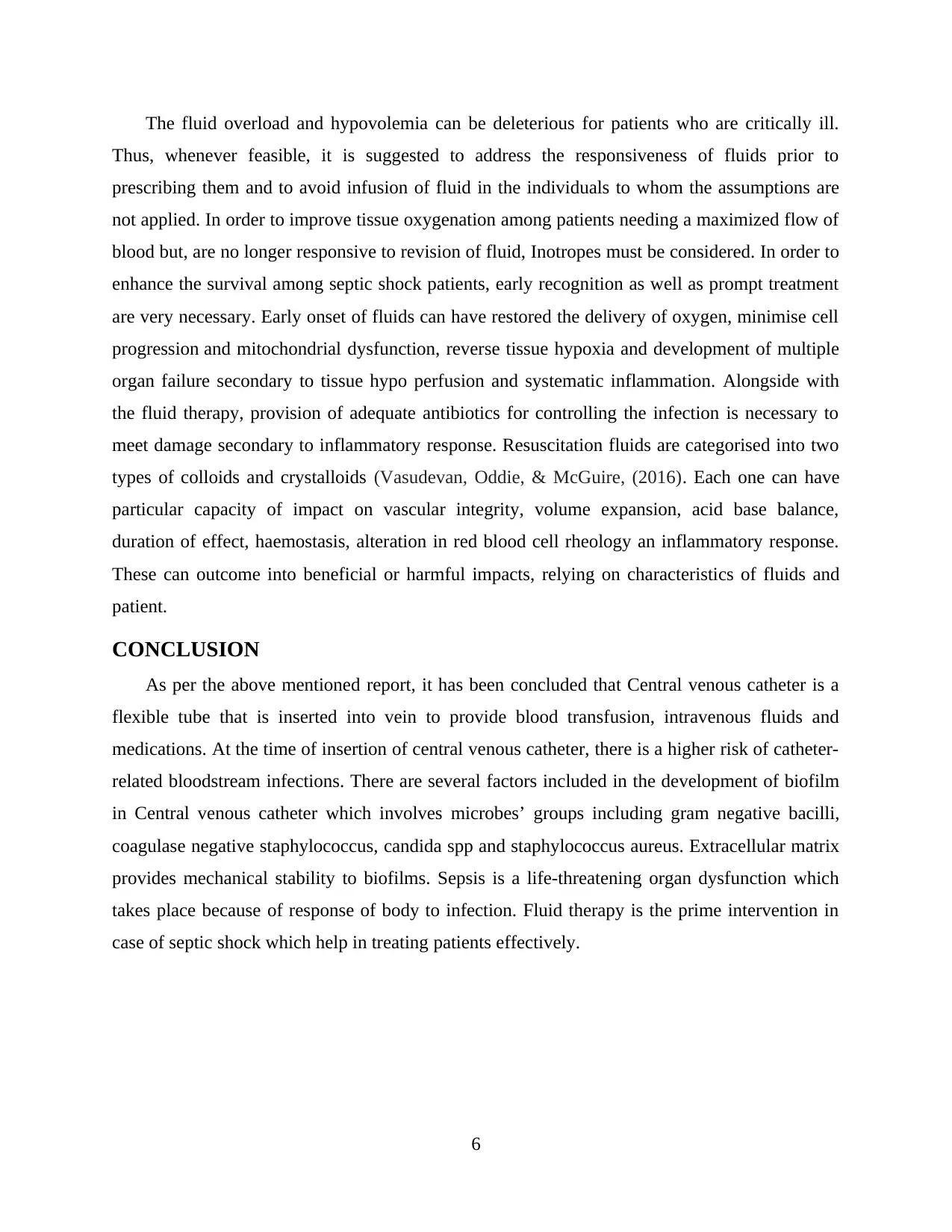
The fluid overload and hypovolemia can be deleterious for patients who are critically ill.
Thus, whenever feasible, it is suggested to address the responsiveness of fluids prior to
prescribing them and to avoid infusion of fluid in the individuals to whom the assumptions are
not applied. In order to improve tissue oxygenation among patients needing a maximized flow of
blood but, are no longer responsive to revision of fluid, Inotropes must be considered. In order to
enhance the survival among septic shock patients, early recognition as well as prompt treatment
are very necessary. Early onset of fluids can have restored the delivery of oxygen, minimise cell
progression and mitochondrial dysfunction, reverse tissue hypoxia and development of multiple
organ failure secondary to tissue hypo perfusion and systematic inflammation. Alongside with
the fluid therapy, provision of adequate antibiotics for controlling the infection is necessary to
meet damage secondary to inflammatory response. Resuscitation fluids are categorised into two
types of colloids and crystalloids (Vasudevan, Oddie, & McGuire, (2016). Each one can have
particular capacity of impact on vascular integrity, volume expansion, acid base balance,
duration of effect, haemostasis, alteration in red blood cell rheology an inflammatory response.
These can outcome into beneficial or harmful impacts, relying on characteristics of fluids and
patient.
CONCLUSION
As per the above mentioned report, it has been concluded that Central venous catheter is a
flexible tube that is inserted into vein to provide blood transfusion, intravenous fluids and
medications. At the time of insertion of central venous catheter, there is a higher risk of catheter-
related bloodstream infections. There are several factors included in the development of biofilm
in Central venous catheter which involves microbes’ groups including gram negative bacilli,
coagulase negative staphylococcus, candida spp and staphylococcus aureus. Extracellular matrix
provides mechanical stability to biofilms. Sepsis is a life-threatening organ dysfunction which
takes place because of response of body to infection. Fluid therapy is the prime intervention in
case of septic shock which help in treating patients effectively.
6
Thus, whenever feasible, it is suggested to address the responsiveness of fluids prior to
prescribing them and to avoid infusion of fluid in the individuals to whom the assumptions are
not applied. In order to improve tissue oxygenation among patients needing a maximized flow of
blood but, are no longer responsive to revision of fluid, Inotropes must be considered. In order to
enhance the survival among septic shock patients, early recognition as well as prompt treatment
are very necessary. Early onset of fluids can have restored the delivery of oxygen, minimise cell
progression and mitochondrial dysfunction, reverse tissue hypoxia and development of multiple
organ failure secondary to tissue hypo perfusion and systematic inflammation. Alongside with
the fluid therapy, provision of adequate antibiotics for controlling the infection is necessary to
meet damage secondary to inflammatory response. Resuscitation fluids are categorised into two
types of colloids and crystalloids (Vasudevan, Oddie, & McGuire, (2016). Each one can have
particular capacity of impact on vascular integrity, volume expansion, acid base balance,
duration of effect, haemostasis, alteration in red blood cell rheology an inflammatory response.
These can outcome into beneficial or harmful impacts, relying on characteristics of fluids and
patient.
CONCLUSION
As per the above mentioned report, it has been concluded that Central venous catheter is a
flexible tube that is inserted into vein to provide blood transfusion, intravenous fluids and
medications. At the time of insertion of central venous catheter, there is a higher risk of catheter-
related bloodstream infections. There are several factors included in the development of biofilm
in Central venous catheter which involves microbes’ groups including gram negative bacilli,
coagulase negative staphylococcus, candida spp and staphylococcus aureus. Extracellular matrix
provides mechanical stability to biofilms. Sepsis is a life-threatening organ dysfunction which
takes place because of response of body to infection. Fluid therapy is the prime intervention in
case of septic shock which help in treating patients effectively.
6
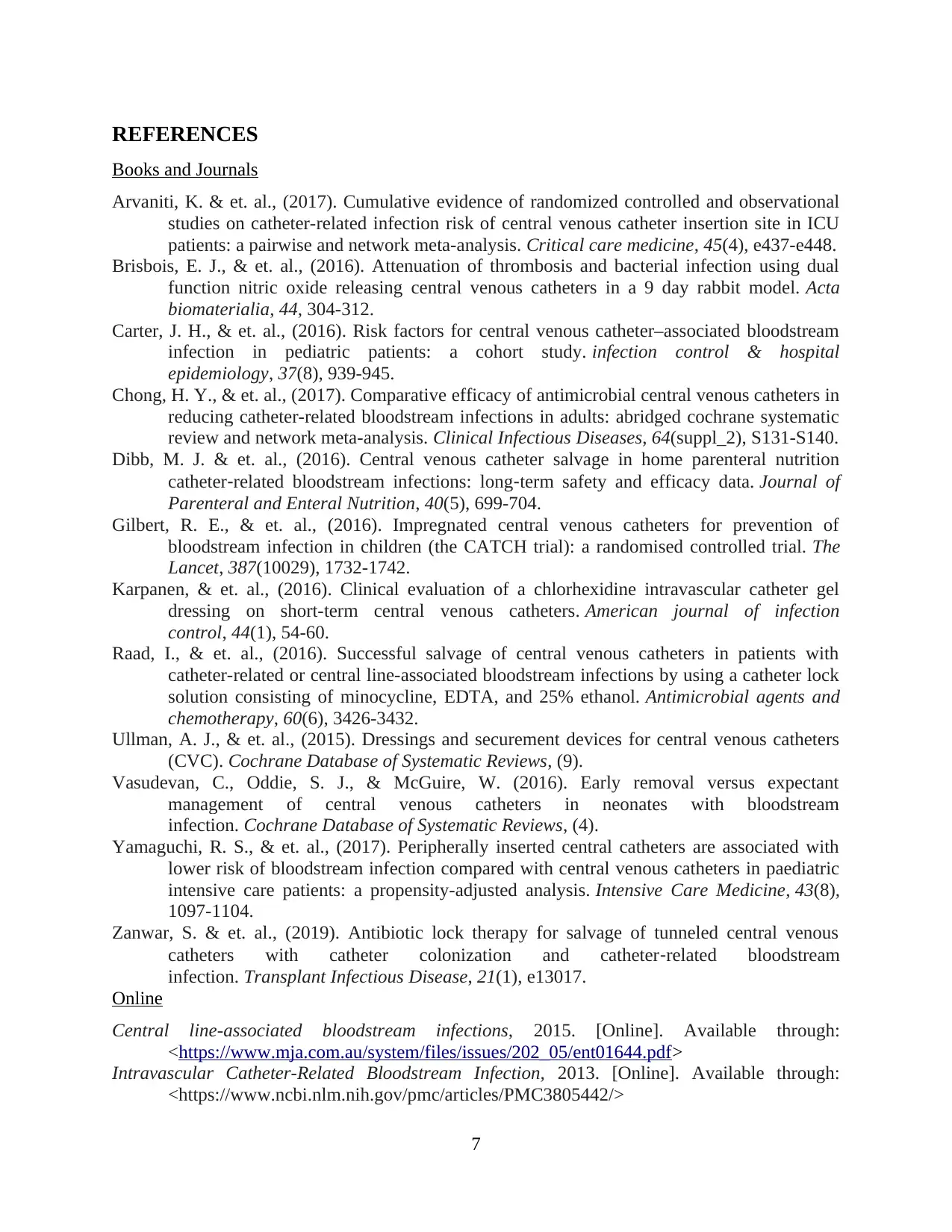
REFERENCES
Books and Journals
Arvaniti, K. & et. al., (2017). Cumulative evidence of randomized controlled and observational
studies on catheter-related infection risk of central venous catheter insertion site in ICU
patients: a pairwise and network meta-analysis. Critical care medicine, 45(4), e437-e448.
Brisbois, E. J., & et. al., (2016). Attenuation of thrombosis and bacterial infection using dual
function nitric oxide releasing central venous catheters in a 9 day rabbit model. Acta
biomaterialia, 44, 304-312.
Carter, J. H., & et. al., (2016). Risk factors for central venous catheter–associated bloodstream
infection in pediatric patients: a cohort study. infection control & hospital
epidemiology, 37(8), 939-945.
Chong, H. Y., & et. al., (2017). Comparative efficacy of antimicrobial central venous catheters in
reducing catheter-related bloodstream infections in adults: abridged cochrane systematic
review and network meta-analysis. Clinical Infectious Diseases, 64(suppl_2), S131-S140.
Dibb, M. J. & et. al., (2016). Central venous catheter salvage in home parenteral nutrition
catheter‐related bloodstream infections: long‐term safety and efficacy data. Journal of
Parenteral and Enteral Nutrition, 40(5), 699-704.
Gilbert, R. E., & et. al., (2016). Impregnated central venous catheters for prevention of
bloodstream infection in children (the CATCH trial): a randomised controlled trial. The
Lancet, 387(10029), 1732-1742.
Karpanen, & et. al., (2016). Clinical evaluation of a chlorhexidine intravascular catheter gel
dressing on short-term central venous catheters. American journal of infection
control, 44(1), 54-60.
Raad, I., & et. al., (2016). Successful salvage of central venous catheters in patients with
catheter-related or central line-associated bloodstream infections by using a catheter lock
solution consisting of minocycline, EDTA, and 25% ethanol. Antimicrobial agents and
chemotherapy, 60(6), 3426-3432.
Ullman, A. J., & et. al., (2015). Dressings and securement devices for central venous catheters
(CVC). Cochrane Database of Systematic Reviews, (9).
Vasudevan, C., Oddie, S. J., & McGuire, W. (2016). Early removal versus expectant
management of central venous catheters in neonates with bloodstream
infection. Cochrane Database of Systematic Reviews, (4).
Yamaguchi, R. S., & et. al., (2017). Peripherally inserted central catheters are associated with
lower risk of bloodstream infection compared with central venous catheters in paediatric
intensive care patients: a propensity-adjusted analysis. Intensive Care Medicine, 43(8),
1097-1104.
Zanwar, S. & et. al., (2019). Antibiotic lock therapy for salvage of tunneled central venous
catheters with catheter colonization and catheter‐related bloodstream
infection. Transplant Infectious Disease, 21(1), e13017.
Online
Central line-associated bloodstream infections, 2015. [Online]. Available through:
<https://www.mja.com.au/system/files/issues/202_05/ent01644.pdf>
Intravascular Catheter-Related Bloodstream Infection, 2013. [Online]. Available through:
<https://www.ncbi.nlm.nih.gov/pmc/articles/PMC3805442/>
7
Books and Journals
Arvaniti, K. & et. al., (2017). Cumulative evidence of randomized controlled and observational
studies on catheter-related infection risk of central venous catheter insertion site in ICU
patients: a pairwise and network meta-analysis. Critical care medicine, 45(4), e437-e448.
Brisbois, E. J., & et. al., (2016). Attenuation of thrombosis and bacterial infection using dual
function nitric oxide releasing central venous catheters in a 9 day rabbit model. Acta
biomaterialia, 44, 304-312.
Carter, J. H., & et. al., (2016). Risk factors for central venous catheter–associated bloodstream
infection in pediatric patients: a cohort study. infection control & hospital
epidemiology, 37(8), 939-945.
Chong, H. Y., & et. al., (2017). Comparative efficacy of antimicrobial central venous catheters in
reducing catheter-related bloodstream infections in adults: abridged cochrane systematic
review and network meta-analysis. Clinical Infectious Diseases, 64(suppl_2), S131-S140.
Dibb, M. J. & et. al., (2016). Central venous catheter salvage in home parenteral nutrition
catheter‐related bloodstream infections: long‐term safety and efficacy data. Journal of
Parenteral and Enteral Nutrition, 40(5), 699-704.
Gilbert, R. E., & et. al., (2016). Impregnated central venous catheters for prevention of
bloodstream infection in children (the CATCH trial): a randomised controlled trial. The
Lancet, 387(10029), 1732-1742.
Karpanen, & et. al., (2016). Clinical evaluation of a chlorhexidine intravascular catheter gel
dressing on short-term central venous catheters. American journal of infection
control, 44(1), 54-60.
Raad, I., & et. al., (2016). Successful salvage of central venous catheters in patients with
catheter-related or central line-associated bloodstream infections by using a catheter lock
solution consisting of minocycline, EDTA, and 25% ethanol. Antimicrobial agents and
chemotherapy, 60(6), 3426-3432.
Ullman, A. J., & et. al., (2015). Dressings and securement devices for central venous catheters
(CVC). Cochrane Database of Systematic Reviews, (9).
Vasudevan, C., Oddie, S. J., & McGuire, W. (2016). Early removal versus expectant
management of central venous catheters in neonates with bloodstream
infection. Cochrane Database of Systematic Reviews, (4).
Yamaguchi, R. S., & et. al., (2017). Peripherally inserted central catheters are associated with
lower risk of bloodstream infection compared with central venous catheters in paediatric
intensive care patients: a propensity-adjusted analysis. Intensive Care Medicine, 43(8),
1097-1104.
Zanwar, S. & et. al., (2019). Antibiotic lock therapy for salvage of tunneled central venous
catheters with catheter colonization and catheter‐related bloodstream
infection. Transplant Infectious Disease, 21(1), e13017.
Online
Central line-associated bloodstream infections, 2015. [Online]. Available through:
<https://www.mja.com.au/system/files/issues/202_05/ent01644.pdf>
Intravascular Catheter-Related Bloodstream Infection, 2013. [Online]. Available through:
<https://www.ncbi.nlm.nih.gov/pmc/articles/PMC3805442/>
7
⊘ This is a preview!⊘
Do you want full access?
Subscribe today to unlock all pages.

Trusted by 1+ million students worldwide

Incidence of Central Venous Catheter-Related Bloodstream Infections, 2019. [Online]. Available
through: <https://www.hindawi.com/journals/tswj/2019/1025032/>
Central venous catheter-related bloodstream infections in the intensive care unit, 2011. [Online].
Available through: < https://www.ncbi.nlm.nih.gov/pmc/articles/PMC3271557/>
Biofilm Formation on Central Venous Catheters, 2017. [Online]. Available through:
<https://onlinelibrary.wiley.com/doi/full/10.1111/apm.12665>
8
through: <https://www.hindawi.com/journals/tswj/2019/1025032/>
Central venous catheter-related bloodstream infections in the intensive care unit, 2011. [Online].
Available through: < https://www.ncbi.nlm.nih.gov/pmc/articles/PMC3271557/>
Biofilm Formation on Central Venous Catheters, 2017. [Online]. Available through:
<https://onlinelibrary.wiley.com/doi/full/10.1111/apm.12665>
8
1 out of 10
Related Documents
Your All-in-One AI-Powered Toolkit for Academic Success.
+13062052269
info@desklib.com
Available 24*7 on WhatsApp / Email
![[object Object]](/_next/static/media/star-bottom.7253800d.svg)
Unlock your academic potential
Copyright © 2020–2025 A2Z Services. All Rights Reserved. Developed and managed by ZUCOL.





